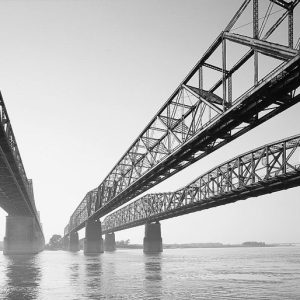calsfoundation@cals.org
Big River Crossing
aka: Harahan Bridge
The Harahan Bridge, which spans the Mississippi River to connect Memphis, Tennessee, with West Memphis (Crittenden County), was built in 1916 as a two-track railroad bridge and converted in 2016 to add a bicycle and pedestrian pathway, replacing one of the old abandoned auto roadways; the structure was renamed Big River Crossing. The Union Pacific Railroad owns the bridge and agreed to add the pathway, which was financed with a federal grant. The new pathway connects Main Street in Memphis to the Delta Regional River Park on the Arkansas side and to the Big River Trail. After completion, the Big River Trail, for use by pedestrians and bikers, will extend from the head waters of the river to the Gulf Coast along the levees on the western side.
The Harahan Bridge, completed in 1916, was needed to supplement the existing single-track Frisco Bridge completed in 1892, which, by the turn of the century, was not adequate to accommodate increasing rail traffic. Three railroad companies—the Rock Island, the Cotton Belt, and the Iron Mountain—built the bridge as a joint venture. The Harahan had two railroad tracks, and a one-way “wagonway” was bolted onto each side. These vehicle roadways were turned over to Crittenden County, Arkansas, and the City of Memphis to be used without toll.
The bridge was named for James Harahan, former president of the Illinois Central Railroad, who foresaw the need for automobile bridge transit and urged the inclusion of automobile roadways. He was killed in a train accident while the bridge was under construction.
The nearly 5,000-foot-long bridge is a cantilevered through-truss-type construction. The approach from the Arkansas side was a 2.5-mile-long viaduct over the bottomland from the St. Francis Levee to the bridge. The primary bridge span is 791 feet, designed to match that of the Frisco Bridge, which at the time of its construction was the third-longest span in the world. The two automobile roadways and the long approach from the Arkansas side were paved with wood planks. The construction took about two years and cost $6,000,000. With the lack of modern heavy construction equipment, the process required much dangerous manual labor and resulted in twenty-three fatal accidents. The piers were built using pneumatic caissons, the same process used for the Frisco Bridge and many other bridges of the day. In 1928, a fire of unknown origin completely burned the eastbound wood-plank roadway, closing it for months.
By the 1940s, the automobile roadways were inadequate for the volume of traffic. The Memphis-Arkansas Memorial Bridge was completed in 1949, with four lanes and sidewalks. It later became the Interstate 55 bridge. The Harahan roadways remained, but after the new bridge was opened, they were used only infrequently by tractors and farm equipment; they were closed in 1954.
The Harahan bridge, as well as the older Frisco Bridge, remains an active railroad bridge in the twenty-first century. Big River Crossing (BRX) opened on October 22, 2016, as the longest public pedestrian/bike bridge across the Mississippi River. Connecting Main Streets in Memphis and West Memphis, the BRX is open daily to pedestrians and cyclists from 6:00 a.m. to 10:00 p.m. It is illuminated after sunset, but the decorative lights are turned off for rail and barge crossings.
For additional information:
Big River Crossing. http://www.bigrivercrossing.com/ (accessed July 10, 2017).
Case, B. M. “New Harahan Bridge across the Mississippi River at Memphis.” Rock Island Employees Magazine, March 1915, pp. 16–22.
“Celebration Postponed.” Arkansas Gazette, June 15, 1916, p. 10.
“Harahan Bridge Is Open to Traffic.” Osceola Times, July 28, 1916, p. 1.
“Some Details of the Great Harahan Bridge of Memphis.” Arkansas Gazette, October 19, 1916, p. 6.
W. W. Satterfield
Little Rock, Arkansas
 Early Twentieth Century, 1901 through 1940
Early Twentieth Century, 1901 through 1940 Transportation
Transportation Memphis-Arkansas Memorial Bridge
Memphis-Arkansas Memorial Bridge 




Comments
No comments on this entry yet.